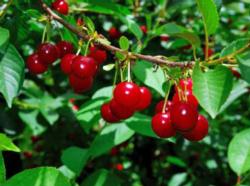Unused stories
Growing In Your Garden Now - Cherries

Two types of cherries can be planted: sweet, for fresh eating, and sour, for pies and preserves. Generally, cherries are the most difficult trees to keep alive. They do not tolerate “wet feet” and are very susceptible to brown rot, bacterial canker, cytospora canker, root and crown rots and several viruses.
Sweet cherry trees, Prunus avium L must be planted 14–20 ft. apart in well-drained soil and up on a small mound or berm. Sweet cherries require cross-pollination and require
Calendar of Gardening Activities for Cherries
Winter Dormant Season
- Spray with dormant oil to control San Jose scale.
- Prune 10% of last year’s growth on mature trees to let light in.
- Remove broken, diseased branches. Cherries may do better against bacterial canker (gummosis) if treated with fixed copper spray.
Spring Bloom Season
- Apply fungicide to control brown rot at popcorn and full bloom stages.
- Fertilize non-irrigated mature trees just before or during a rain with about 2 pounds urea or 70 pounds manure. Irrigated trees are fertilized just before an irrigation.
Spring/Summer Harvest Season
- Cover trees with bird netting to control birds.
- Drip irrigate daily. Sprinkler irrigate about every 2–3 weeks with 3–5” water/irrigation, depending on soil depth and water use.
- After harvest, fertilize mature trees with 2 pounds urea and water in immediately.
Summer/Fall Tree Growth
- Irrigate to maintain good tree vigor through summer heat and into fall until winter rain takes over.
- Drip irrigate daily to match daily use. Sprinkler irrigate every 3–4 weeks to wet all soil in root zone but stop September 1 to prevent root rot.
Courtesy of UC California Backyard Orchard website; edited by N Londeree,
2/28/13
